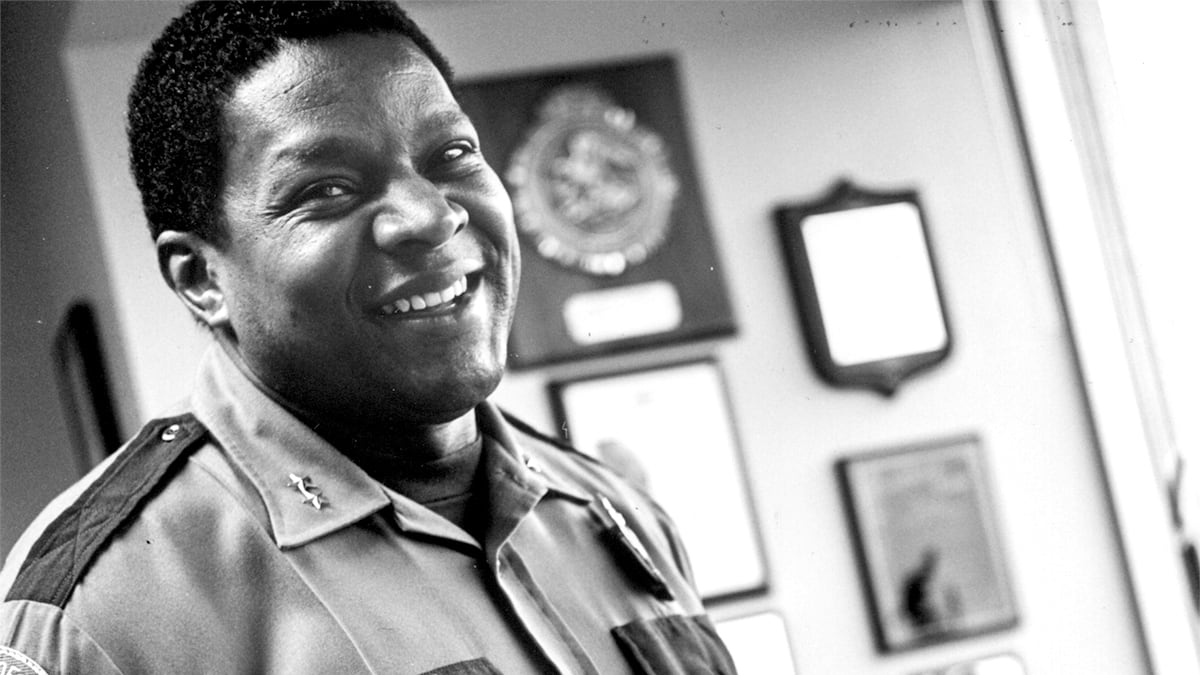On Thanksgiving Day, Charles Moose, Portland’s first Black police chief, died while watching a football game on television. He was 68 years old.
Moose hadn’t lived in Portland for some time. He left in 1999 and moved to Montgomery County, Md., where many people remember him as the senior law enforcement officer in the 2002 Beltway Sniper case.
But it was where he lived in Portland—in the center of a Black neighborhood ravaged by violent crime—that made him a national sensation, and a singular figure in civic history.
In 1993, not long after his swearing-in, Moose and his wife, Sandy, purchased a home at 422 NE Going St. A block off Northeast Martin Luther King Jr. Boulevard, the house was in the King neighborhood, which at the time had one of the city’s highest crime rates.
And everyone freaked out.
Moose was all over the local media, and the national news picked up on it, too. Moose’s house purchase was featured in The New York Times and on ABC’s World News Saturday, NBC News and the CBS Evening News. Connie Chung introduced the nation to Portland’s police chief. When U.S. Attorney General Janet Reno came to Portland in 1994, she and Mayor Vera Katz toured Moose’s home and the King neighborhood, cameras a-clicking.
City leaders of his stature, at his pay rate, did not just buy a house “in the bad part of town.” This was progressive and new.
Moose said he was “reclaiming the neighborhood.” In a city recovering from a wave of homicides that wouldn’t be exceeded until this year, Moose was making a visible commitment to his most deeply cherished ideal: community policing.
The lessons from his experiment are worth recalling in a city that is once again frustrated by crime and blight, and enduring violence that disproportionately kills Black men.
In Moose’s explanation, community policing “recognized that when a police agency simply responds to calls for service, investigating crimes, and making arrests, sustained reductions in crime do not necessarily occur.…Unless the police are willing to link up with other public and private agencies, the complicated social problems that often serve as the underlying causes of crime cannot be solved.”
At the time, Portland Mayor Bud Clark used a biblical turn of phrase for the community policing program: “Police others as you would have others police you. Our officers will move from being crime fighters to being problem solvers.”
Moose did not bring community policing to Portland. Police Chief Tom Potter did. But whereas Potter was the strategic visionary (he called community policing “the Peace Corps of the ‘90s”), Moose was the tactician. He created a playbook.
As he was working on his dissertation for his doctorate in urban studies at Portland State University, he took his theories of community policing and dropped them on Iris Court, a high-crime public housing complex off of North Alberta Street.
In his 1993 dissertation, Moose argued that police had conceived of their jobs too narrowly. Instead, with his plan, “police would promote the common good, serve as community social workers as well as law enforcers, and so on.” Not a standard mission for a police department. For Moose, job training and nutrition classes would be as important as fighting crime.
In Moose’s policing, the police officer was a social worker as much or even more than a crime fighter. Community policing looked to stop crimes in progress, but it also to identify the whys of crime and address those societal issues.
It was a long game. If Portland has more jobs, will people stop breaking into homes to steal VCRs? Is obesity an issue that can be addressed with nutritional classes? What sort of activities do children have after school and during breaks? Under Moose’s policing, all those services were to be delivered to citizens by the Portland Police Bureau.
The chief brought a Black Santa to the Iris Court Christmas party. That was his model: cops with Santas.
By contrast, Moose also ushered in the arrival of AR-15 rifles for the Police Bureau. In 1997, he formed the “Long Gun Option Committee,” police archives show. In 1999, thanks largely to Moose’s efforts, the city purchased 225 AR-15s.
When his move into the King neighborhood captured attention, Moose wanted to expand his vision of police officers reclaiming places. In August 1993, more than half of the bureau’s officers lived outside the city of Portland. By February 1995, that disparity had increased. Of 1,006 sworn officers, only 341 lived within city limits.
So, in 1995, Mayor Vera Katz and Moose partnered with five local banks to create the “Police at Home” program.
The purpose was simple, city archives show: “to encourage Portland police officers to purchase homes in targeted areas.” With this loan financing incentive, police officers could get a home loan with no money down and zero out-of-pocket closing costs. The officer would need to live in the home for five years, and the home had to be in one of eight targeted neighborhoods.
“This sends a clear message that you don’t have to run from these neighborhoods,” Moose told The Oregonian. He hoped to have an officer living on every city block.
It didn’t work that way. Only 22 officers purchased homes with the program. Instead, the effect of Moose’s plan was a different kind of dramatic change. The city’s first Black police chief made white Portlanders feel safe buying houses in Northeast Portland.
Moose knew the term “gentrification,” and he didn’t shy away from it. At his 1999 City Club of Portland address, Moose told attendees, “I find it quite fascinating now that the issue most often talked about in the King neighborhood is gentrification. We’re not talking about homicide, we’re not talking about gang activity. People are talking about: Things are going too well. People are moving in.
“Now, I understand all of the issues and the ramifications to gentrification, and I want to be respectful in regards to that. But in terms of talking about crime, the mayor and I would much rather talk about gentrification than shots fired, or drive-by shootings.”
Several of Moose’s contemporaries remain skeptical of community policing to this day.
“To be honest, community policing was always BS,” says CW Jensen, Moose’s public information officer for several years. “We went to lots more meetings about petty shit. People that interact with cops generally have some parochial issue. When their issue was solved, they were done with community policing.”
The term “community policing” gets brought up regularly in Portland, both by the police union and by mayoral candidates who like the idea of friendly officers on bikes. But the city never again fully embraced Moose’s vision of policing as a compact between citizens and officers—or the idea that police could serve a role more fundamental than responding to crime or crisis.
Today, the Portland Police Bureau remains understaffed and still faces criticism for not having enough officers living in the city.
Sgt. Pete Simpson says after Moose left, the city never committed to the idea in the way that mattered: assigning people to the task. “You need extra officers who aren’t tied to answering calls for service so that they have the time to spend in the neighborhood engaging with the community,” he tells WW. “Many of these assignments or units were eliminated and, with them, the community connections that were the core of community policing.”
And perhaps also eliminated was an opportunity to ask ourselves if we would want to be policed differently.
Doug Kenck-Crispin is the resident historian of the podcast Kick Ass Oregon History. While completing his master’s degree at Portland State University, he wrote his thesis on Charles Moose.

